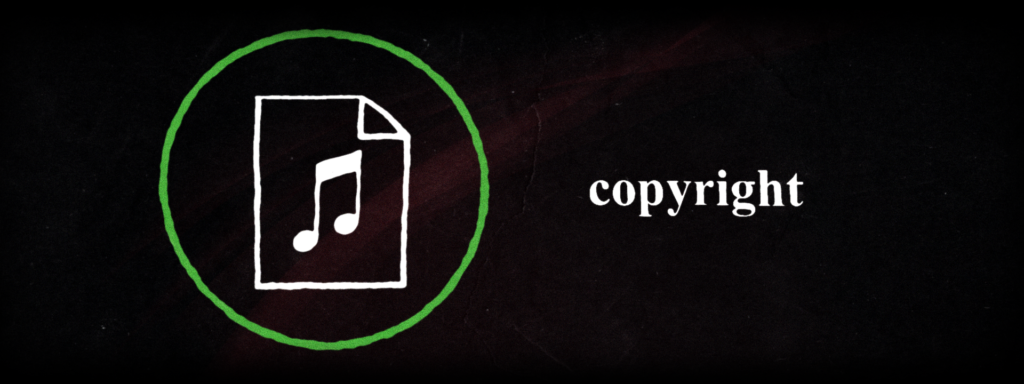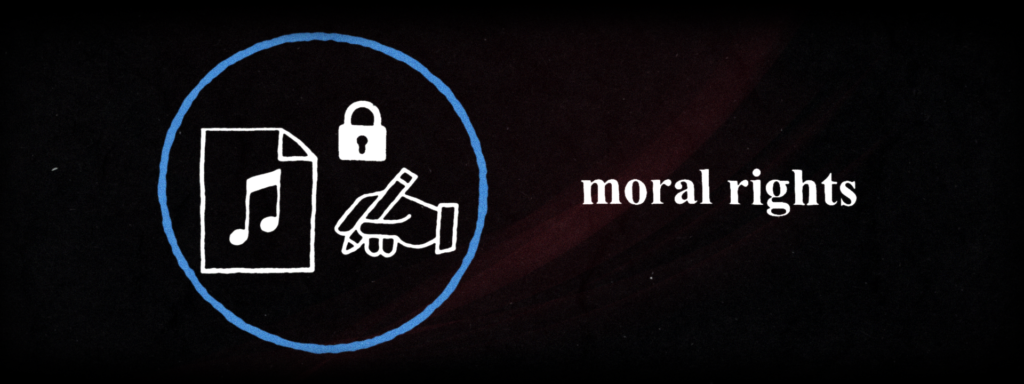
In the context of intellectual property, exploitation is a positive thing in most countries. The more a creation is legally exploited—that is, sold, performed, published, adapted, translated, synchronized, copied, or otherwise used—the more income it generates for the creator.
Music creators must understand what legal rights they’re afforded and how those rights can be administered and protected in order to maximize their revenue and collect every dollar they’re entitled to.
Copyright

A “copyright” is actually a bundle of rights that a creator—or “author”—of an original work owns. In Canada, copyright law is outlined in the Copyright Act.
The vast majority of the world’s countries—Canada among them—have based their copyright legislation on the principles outlined in an international agreement (the Berne Convention), which is administered by the UN’s World Intellectual Property Organization. This ensures that the copyright in a creative work receives very similar legal protections in most countries, regardless of where it originated.
Most nations also agree that a copyright is automatically generated the moment an original work is captured or fixed in some tangible form. In other words, as soon as a music creator writes a composition or records a song, that musical work is under copyright protection. But it can’t just be a tune that’s in your head.
The rights covered by copyright that are most pertinent to music creators include the rights to produce, reproduce, publicly perform, publish, translate, record, and share via telecommunication a creative work or any part of it.1 And this collection of rights can be divided into two main categories—performing rights and reproduction rights.
Registration of copyright is entirely voluntary, and it can be done through the Canadian Intellectual Property Office for a nominal one-time fee. It officially certifies the ownership of a copyright, making it easier to protect against infringement, but it does not provide any additional legal benefits. (This differs from US copyright law, under which registration is a prerequisite for filing infringement claims.)
Duration
Canadian law says that a copyright is protected for the entirety of the author’s life—and for an additional 50 years after their death (or the death of the last living creator in the case of joint authorship). However, by the end of 2022, Canada has committed to extending the posthumous protection to 70 years (which is already the standard in the US).2
Public Domain
Once copyright protection expires, the work enters the public domain, which means that it can be used by anyone for free and without permission, and the previous owner of the copyright (which is often the creator’s estate) will no longer receive royalties.
However, translations, adaptations (including musical arrangements and orchestrations), and recordings (including cover versions) of musical works in the public domain are each protected under their own copyright, provided that they can be considered original creations in and of themselves. For example, while the classic Christmas carol “Silent Night” is in the public domain, Sarah McLachlan’s arrangement of the song is under copyright (and the 2006 sound recording of that arrangement is under its own copyright as well).
Assignment vs. licensing
The first owner of the copyright, which is typically the author, is permitted to transfer ownership of some or all the rights associated with their work to another party at any time. This grant of ownership is called an “assignment.” However, in Canada, an assignment currently only remains in effect until 25 years after the death of the author, at which time ownership and control of the copyright revert back to the author’s estate for the final 25 years of the term (this is often referred to as the “reversionary right”).
Alternatively, if the author retains ownership of the copyright, they can still allow others to use their creative work via licensing. A licence is simply the owner’s legal authorization to use their work in a particular way. For example, if a bar hires a band to perform live music, it must obtain a valid performance licence. And if a record label or artist wishes to make a recording of a musical work, it must obtain a mechanical licence.
Music creators (particularly songwriters) frequently negotiate a voluntary assignment of a portion of the copyright in their works to music publishers who, in turn, work to exploit it on their behalf. This is formalized via a publishing agreement, under which the creator is likely to receive upfront compensation—in the form of an advance against future earnings—in exchange for the rights assigned to the publisher. Learn more about publishing agreements.
Creators may also assign certain rights to collective societies (e.g., performing rights to SOCAN) so these organizations can administer the rights—that is, grant licences and collect royalties—on their behalf. It should be noted, however, that collective societies are not assigned any share of the copyright itself.
As first owners of copyright, music creators are entitled to receive royalties from the licence fees paid by the users of their works. However, in certain instances, they may be asked, or even required as a condition of their engagement, to waive their right to receive some or all of the future revenue generated by their creations. Such arrangements are often referred to as “buyouts,” and it’s vitally important for music creators to understand their implications. Read more about buyouts.
“Work Made in the Course of Employment” & “Work for Hire”
An important exception to the rule that the author is automatically the first owner of copyright applies when they are an employee at the time they create a work. The Copyright Act calls this “work made in the course of employment,” and, in such instances, the employer—not the author—is deemed to be the first owner of copyright.3
A number of factors determine whether someone is legally considered an employee (i.e., their legal employee status). These include how their working relationship with the employer is defined in their contract, whether they are paid a salary with Canada Pension Plan (CPP) and Employment Insurance (EI) contributions deducted, whether they are eligible to receive medical benefits through the employer’s insurance plan, etc.
It is vital to note that, in most cases, Canadian music creators are independent contractors, not employees. Therefore, they should reject the inclusion of “Work Made in the Course of Employment” language in any contract of engagement, and insist on recognition that they are the first owner of copyright in their works.
“Work made in the course of employment” differs somewhat from “work for hire” (or “work made for hire”), which is a provision in US copyright law that recognizes both the exception noted above and a second one. In short, when a client hires an independent contractor to create a work that falls into a specific category listed in the US Copyright Act—including “part of a motion picture or other audiovisual work”—the client may be designated the first owner of copyright in that work, as long as all parties agree.4
It is crucially important to understand that, by signing a “work for hire” agreement, a music creator is likely to be assigning ownership of all their rights in a musical work—and all the subsequent royalties (including the writer’s share)—to the client. However, since Canadian copyright law does not recognize the US “work for hire” provision, music creators regularly and successfully contest its inclusion in Canadian contracts.
For more information on Canadian copyright law, please visit the Copyright Board FAQ page.
For information on US copyright law, please visit the US Copyright Office FAQ page.

A Note on Moral Rights
Whenever an original work is created, “moral rights” are generated in tandem with—but distinct from—the copyright. Also outlined in the Berne Convention and the Copyright Act of Canada, they include the creator’s right “to be associated with the work as its author by name or under a pseudonym and…to remain anonymous” (also known as the right of “paternity” or “attribution”) and “the right to the integrity of the work.”5
The act clarifies that a work’s integrity is infringed upon if the work is “distorted, mutilated or otherwise modified” or “used in association with a product, service, cause or institution” that harms the author’s “honour or reputation.”6
In Canada, moral rights exist throughout the full duration of copyright. And though they cannot be assigned to anyone else (even if full ownership of the copyright is transferred), they can be waived—as long as it is done explicitly. Canadian screen composers are often asked to waive all moral rights in works created for audiovisual (AV) productions. But while they frequently agree to waive the right of integrity, they often successfully insist on retaining the right of attribution.
These parameters differ elsewhere in the world. In some European nations, for example, moral rights exist in perpetuity, even after a work enters the public domain, and they cannot be fully waived. Conversely, in the US, moral rights associated with musical works aren’t recognized at all. In fact, only works of visual art are formally protected by moral rights.
In Canada, moral rights exist throughout the full duration of copyright. And though they cannot be assigned to anyone else (even if full ownership of the copyright is transferred), they can be waived—as long as it is done explicitly. Canadian screen composers are often asked to waive all moral rights in works created for audiovisual (AV) productions. But while they frequently agree to waive the right of integrity, they often successfully insist on retaining the right of attribution.
These parameters differ elsewhere in the world. In some European nations, for example, moral rights exist in perpetuity, even after a work enters the public domain, and they cannot be fully waived. Conversely, in the US, moral rights associated with musical works aren’t recognized at all. In fact, only works of visual art are formally protected by moral rights.
1 https://laws-lois.justice.gc.ca/eng/acts/c-42/page-2.html#h-102726
2 https://www.international.gc.ca/trade-commerce/trade-agreements-accords-commerciaux/agr-acc/cusma-aceum/text-texte/20.aspx?lang=eng See Article 20.62.
3 https://laws-lois.justice.gc.ca/eng/acts/C-42/page-3.html#h-102834
4 https://www.copyright.gov/circs/circ30.pdf (PDF)
5 https://laws-lois.justice.gc.ca/eng/acts/C-42/page-3.html#h-102861
6 https://laws-lois.justice.gc.ca/eng/acts/C-42/page-6.html#h-103250
